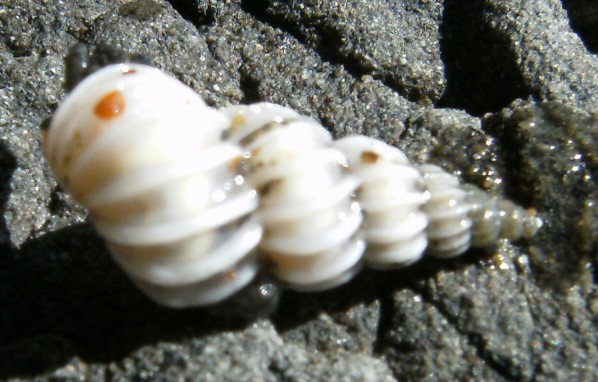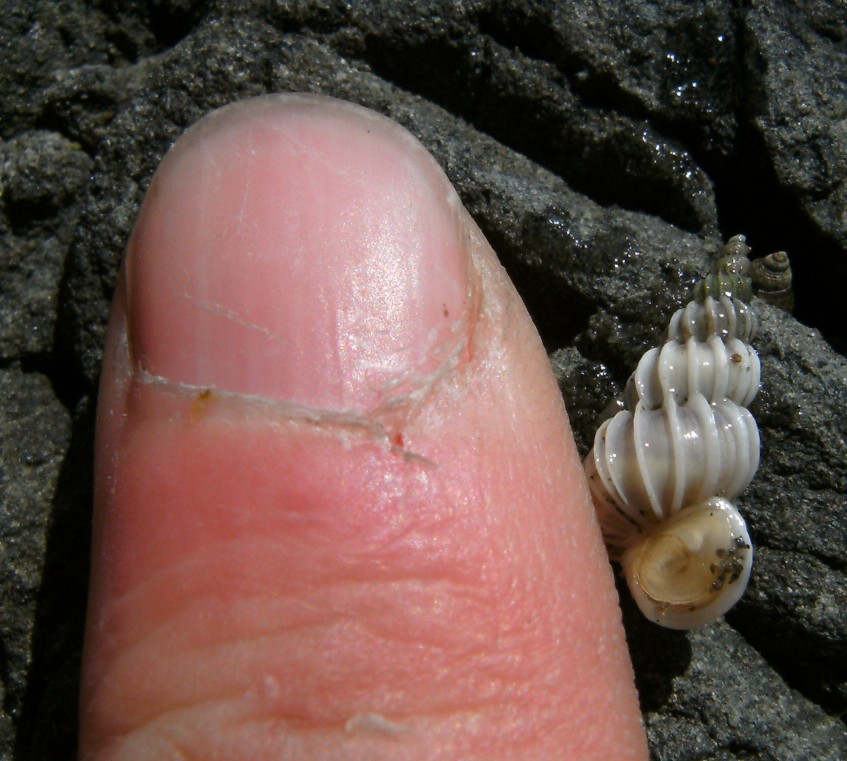Epitonium tinctum (Carpenter, 1864)Common name(s): Tinted wentletrap, white wentletrap, painted wentletrap |
|
| Synonyms: Nitidiscala tincta, Nitidiscala eelense, Epitonium subcornatum, Epitonium indianorum tincta |  |
|
Class Gastropoda
Order Neotaenioglossa
Family Epitoniidae
|
|
| Epitonium tinctum, about 1.5 cm long, from intertidal at San Simeon, CA. The shell was among the bases of Anthopleura elegantissima anemones. | |
| (Photo by: Dave Cowles, August 2010 ) | |
How to Distinguish from
Similar Species:Opalia
species such as Opalia
montereyensis have a strong shoulder or spiral
ridge along the base of the body
whorl. Some other wentletrap species have well over
14 axial
lamellae
or the lamellae
have sharp angles or spines near the suture. Epitonium
indianorum grows larger, is largely offshore and subtidal,
and does
not have the brown or purple line near the suture.
Geographical Range:
Southern Alaska to
Bahia Magdalena, Baja California, Mexico
Depth Range:
Intertidal to 45 m
Habitat: In
sand near anemones, especially Anthopleura;
so it is presumably mostly intertidal.
Biology/Natural History: As with other wentletraps, this species feeds on anemones. It is usually found in sand near the base of Anthopleura elegantissima or Anthopleura xanthogrammica, to which the species is strongly attracted. At high tide (twice a day) it feeds on the tips of the anemone tentacles; then at low tide burrows into the sand. Living wentletraps contain a purple, toxic dye. The dye appears to be an anesthetic and it is thought that the snail may use it to relax the anemone tissues before feeding. While feeding it extends its proboscis which may be longer than the shell. The radula is extended with the proboscis.
The snail shows some attraction to Urticina lofotensis and Epiactis prolifera and it will feed on these species, but the attraction is less than that for Anthopleura. These anemones also show a stronger retraction when bitten by the snail, so perhaps the snail anesthetic is most effective with Anthopleura. They are not attracted to Corynactis californica and are repelled by Metridium senile. Some snails contacting Metridium senile were killed.
The species produces sand-encrusted egg capsules which are strung together by a thread. The capsules are laid among their anemone prey.
Small Pagurus hirsutiusculus hermit crabs frequently inhabit the empty shells.
The name "wentletrap" is from the German or Dutch word for "winding staircase".
| Return to: | |||
| Main Page | Alphabetic Index | Systematic Index | Glossary |
References:
Dichotomous Keys:Carlton, 2007
Kozloff, 1987, 1996
General References:
Harbo,
1997
Hinton,
1987
(Johnson
and Snook, 1955)--probably as E.
bellastriatum
McConnaughey
and McConnaughey, 1986
Morris,
1966
Morris
et al., 1980
Niesen,
1997
Rice,
1973
Ricketts
et al., 1985
Scientific Articles:
Web sites:
General Notes and
Observations: Locations,
abundances, unusual behaviors:

This photo beside my finger shows the very small size of the
shell.
Total length is about 1.5 cm. Note also the horny operculum
with only a small amount of spiral ("paucispiral") pattern.
Authors and Editors of Page:
Dave Cowles (2010): Created original page
CSS coding for page developed by Jonathan Cowles (2007)
Rosario Invertebrates web site provided courtesy of Walla Walla University